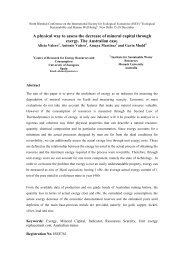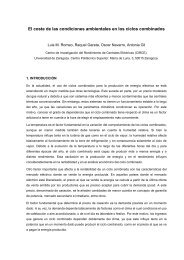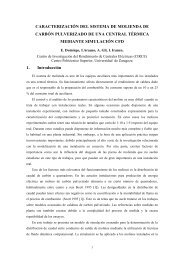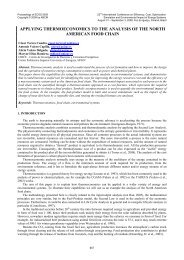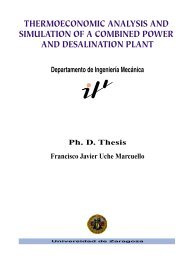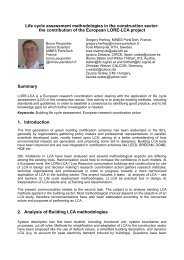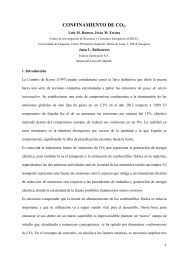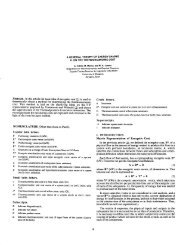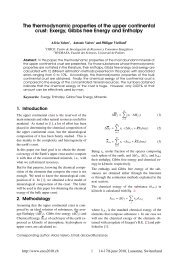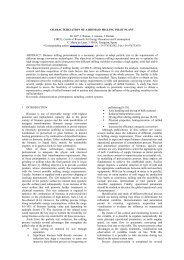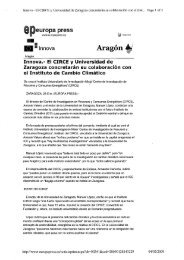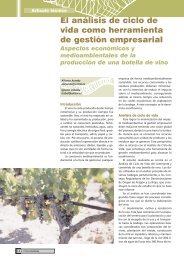Engineering Application of Exergy Analysis - circe - Universidad de ...
Engineering Application of Exergy Analysis - circe - Universidad de ...
Engineering Application of Exergy Analysis - circe - Universidad de ...
Create successful ePaper yourself
Turn your PDF publications into a flip-book with our unique Google optimized e-Paper software.
and 4). Second, due to the high temperature <strong>of</strong><br />
flow 1, the combustion takes place at a high<br />
temperature (above 1400 ºC), which reduces<br />
substantially irreversibility due to heat transfer.<br />
I_combustion (kW)<br />
6000<br />
5000<br />
4000<br />
3000<br />
2000<br />
1000<br />
0<br />
I_combustion (kW) phi_combustion (‐)<br />
0 200 400 600 800 1000 1200<br />
Time (s)<br />
Fig. 7. Irreversibility <strong>of</strong> combustion.<br />
I_HRSG (kW)<br />
40000<br />
35000<br />
30000<br />
25000<br />
20000<br />
15000<br />
10000<br />
5000<br />
0<br />
I_HRSG (kW) phi_HRSG (‐)<br />
0 200 400 600 800 1000 1200<br />
Time (s)<br />
Fig. 8. Irreversibility in the HRSG.<br />
0.1<br />
0.09<br />
0.08<br />
0.07<br />
0.06<br />
0.05<br />
0.04<br />
0.03<br />
0.02<br />
0.01<br />
0<br />
0.5<br />
0.45<br />
0.4<br />
0.35<br />
0.3<br />
0.25<br />
0.2<br />
0.15<br />
0.1<br />
0.05<br />
0<br />
Irreversibility in the heat recovery steam generator<br />
is plotted in Fig. 8. These losses can be as high as<br />
30 MW, or more than 15%. They might be<br />
reduced by consi<strong>de</strong>ring another <strong>de</strong>sign <strong>of</strong> the<br />
boiler, producing steam <strong>of</strong> different levels <strong>of</strong><br />
pressure. It should be noted that the separation <strong>of</strong><br />
combustion and heat transfer has been ma<strong>de</strong> to<br />
simplify the mo<strong>de</strong>l. Accordingly, the actual<br />
distribution <strong>of</strong> losses between these two processes<br />
is not exactly the same as the values calculated<br />
here.<br />
Figure 9 represents irreversibility produced in the<br />
first washing venturi, where gases are cooled from<br />
more than 700 ºC down to less than 100 ºC. This<br />
irreversibility is around 6% <strong>of</strong> the exergy <strong>of</strong> flow<br />
1, and might be reduced by modifying the <strong>de</strong>sign<br />
<strong>of</strong> the HRSG in or<strong>de</strong>r to use a higher part <strong>of</strong> the<br />
thermal exergy <strong>of</strong> gases.<br />
phi_combustion (‐)<br />
phi_HRSG (‐)<br />
I_venturi1 (kW)<br />
20000<br />
18000<br />
16000<br />
14000<br />
12000<br />
10000<br />
8000<br />
6000<br />
4000<br />
2000<br />
0<br />
I_venturi1 (kW) phi_venturi1 (‐)<br />
0 200 400 600 800 1000 1200<br />
Time(s)<br />
Fig. 9. Irreversibility in the first washing venturi.<br />
0.14<br />
0.12<br />
0.1<br />
0.08<br />
0.06<br />
0.04<br />
0.02<br />
Finally, Fig. 10 shows how 2.5 MW <strong>of</strong> exergy are<br />
<strong>de</strong>stroyed without use in the steam con<strong>de</strong>nsers.<br />
This amount may seem not too high compared to<br />
flow 1 (between 1 and 2%), but represents around<br />
20% <strong>of</strong> the exergy <strong>of</strong> steam used in steel<br />
treatments (flow 104). This value only <strong>de</strong>pends on<br />
operation strategy and can be reduced substantially<br />
by a proper management <strong>of</strong> steam storage and<br />
steam export to plant net.<br />
I_con<strong>de</strong>nsers (kW)<br />
3000<br />
2500<br />
2000<br />
1500<br />
1000<br />
500<br />
0<br />
I_con<strong>de</strong>nsers (kW) phi_con<strong>de</strong>nsers (‐)<br />
0 200 400 600 800 1000 1200<br />
Time (s)<br />
Fig. 10. Irreversibility in the con<strong>de</strong>nsers.<br />
3.2. Integral cycle indicators.<br />
0<br />
0<br />
0.035<br />
0.03<br />
0.025<br />
0.02<br />
0.015<br />
0.01<br />
0.005<br />
In this section, parameters <strong>de</strong>fined in (7-10) are<br />
used to summarize the performance <strong>of</strong> the whole<br />
recovery cycle. The main flows appear in Table 1,<br />
and the main components in Table 2.<br />
Table 1. Integral cycle indicators for the main flows<br />
Flow Bcycle (GJ) η cycle(-)<br />
1, gases from converter 193.31 1.0000<br />
9, flared gas 82.92 0.4290<br />
10, recovered gas 59.70 0.3089<br />
104, steam to treatments 11.55 0.0597<br />
135, steam to net -1.686 -0.0087<br />
Accumulated steam 8.438 0.0437<br />
http://www.ecos2010.ch 6 14-17th june 2010, Lausanne, Switzerland<br />
phi_venturi1 (‐)<br />
phi_con<strong>de</strong>nsers (‐)



